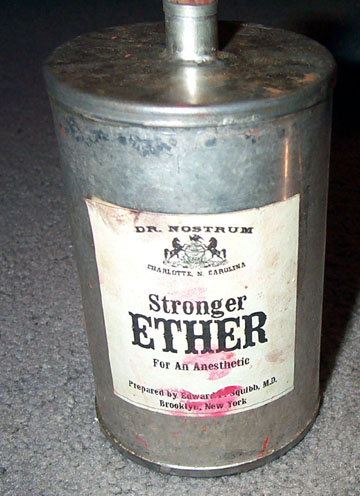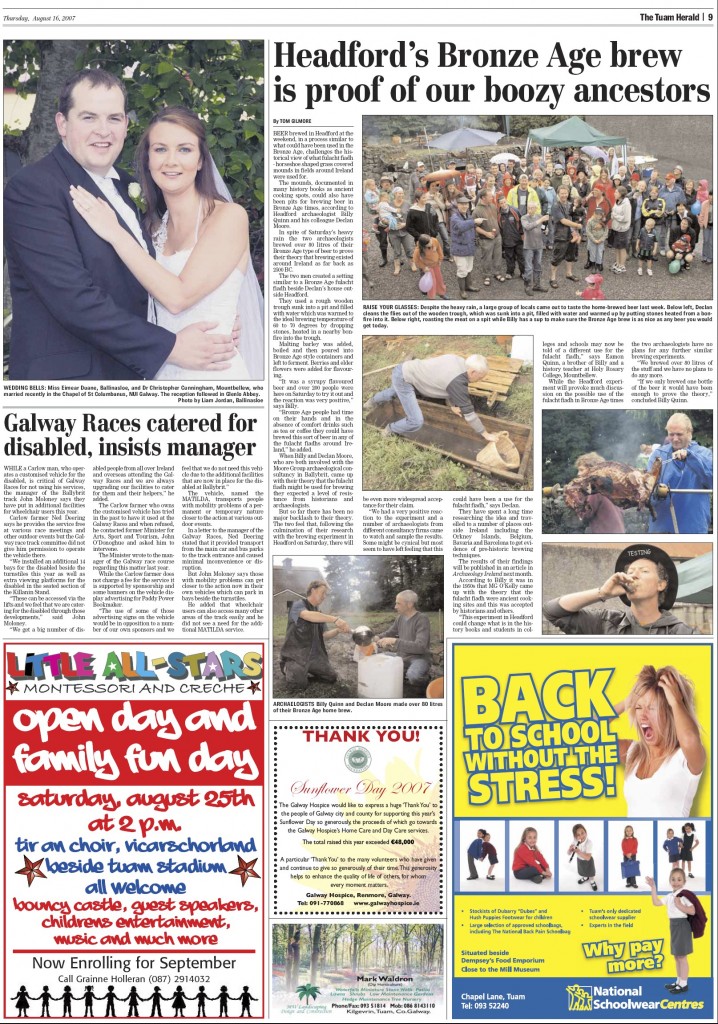Here’s something we just found during a clean up of an old drive.. An article about our very first ‘Headfest’ with group photo, and belated congratulations to the happily wed couple on the facing column.
Blog
THE IBC OF AQUAPONICS
It appears from the hits that we get, that there are still a lot of people out there that are interested in aquaponics and the good news is that for those of you who are, but weren’t sure how to go about it, life just got a whole lot easier. Backyard Aquaponics, from Perth, Western Australia have just released a free PDF publication for download, The IBC of Aquaponics. Now, I may be slightly biased, as my brother is one of the editors, but I think it’s fantastic, with 40mb of instructions, loads of pictures and over 40 examples of people’s own systems. Not only that but many of the examples have links to SketchUp models that can be downloaded and viewed in 3D using Google’s free SketchUp software, where you can see all the details, get dimensions or even make changes to the system to suit your own needs. And I think I have to say it again, it’s FREE!! Congrats to Joel & Faye and all the contributors it’s awesome!
Post Author: Nigel
OUR ‘DAY OF ARCHAEOLOGY’
The Day of Archaeology 2011 aimed to give a window into the daily lives of archaeologists and happened on July 29th. With over 400 contributors, it chronicled what they did on one day, from those in the field through to specialists working in laboratories and behind computers. This was our contribution. To see all the contributions see http://www.dayofarchaeology.com/
For the first time in the history of the company, Moore Group’s team are not nursing hangovers this morning.
By that I don’t mean that it’s a daily occurrence. No. Today is the day after Ladies Day at the Galway Races. Traditionally we’d take the Thursday off to gamble, carouse and revel, dress in our finery and consume copious bottles of champagne, while we watched the fleets of helicopters land and deposit the more affluent racegoers (back when times were good there would be over 300 helicopters a day flying into the Galway Races). And today has traditionally been our recovery day.
We gave the Races our thirties but like the tycoons, we stayed away this year…
The Galway Races From Samuca’s Photostream
The West of Ireland generally closes down for this week of the year and the week coincides with the ‘builders’ holidays (It’s always struck me as odd that the rest of the Country and Non-Ireland continue as normal), so normally we close down for the Thursday and Friday.
But this year, we’re working like everyone else. Unfortunately the crèche isn’t, so my day of archaeology started with toddler transport and grandparent delivery (ie.. delivery of child to said grandparents – he gets to go the races today!). Fortified now with bacon and coffee, I’m back in my home office and preparing to complete a monitoring report. In recent months we’ve downsized and the remaining 4 Moore’s are working ‘in the cloud’. Three have taken the week as holidays and are relaxing at their respective destinations, save Billy, who, presumably, is busy in his home office writing up the notes from his weeks monitoring in Kells, Co. Meath and putting the final touches to an archaeological assessment of a proposed gas pipeline in Limerick.
The main archaeological feature I’ll be writing about in my report today is a section of the medieval bastion of Galway City which was exposed during excavation works for a gas pipeline in the middle of the city as well as the foundation to an earlier defensive tower called the Lion Tower. The bastion wall was found near the centre of Eglinton Street, between Tower House and Cube or Carbon nightclub (not sure which – they didn’t spell it with an initial K, though I’m sure they were tempted). The adjacent Lion Tower (and if there are Galway peeps reading – it is the Lion Tower and not the Lions Tower) foundation was found roughly 2m to the south east of the wall and consisted of a rubble foundation with an upper course of stone that appeared to be laid in an arc. We interpreted this as representing the circular base of the Lion Tower as depicted on the 1651 Pictorial map of Galway, although we had a very narrow area to work in and all the work was done in the evening with limited light.
The Lion Tower/City Bastion as it was in the 30′s (we encountered the foundations in the roadway this side of the second car and the tower foundation opposite the telephone box)
The bastion wall was in good condition and constituted a substantial foundation measuring approximately 2.6m in width built of roughly hewn limestone rubble blocks bonded with lime mortar. Preliminary work on either side of the wall exposed a fair face with a slight batter along the north west facing elevation, the south east face was more ragged. This section of the polygonal bastion was built around the earlier Lion Tower in 1646.
I normally spend the bulk of my time in the office, dealing with clients and potential clients, preparing prices and tenders, accounts and all that dull stuff. The rest of my time is in the field, monitoring pipelines or other construction related activity, site inspections or site visits for assessments of proposed developments, the occasional excavation (not too many of those around these days), and fieldwalking. My deep fear of animals of any description is a definite disadvantage, but I persevere – sheep – I’m desperately frightened of sheep, and dolphins.
Twenty years ago, I stumbled into archaeology, 80’s Ireland presented precious little opportunities but an opportunity to work on an excavation came up after University and I was hooked. Of course, I’ve stumbled a few more times since. Finding things like the bastion makes up for those dull days, as do the days when you find yourself up the top of a mountain, in driving rain, walking through deep bog up to your ankles.
In the early 1960s the late Prof G.A.Hayes-McCoy became a spokesperson for the preservation of the landmark “Lion Tower” described and pictured above (actually a section of the bastion). The ultimate failure of that campaign was a great disappointment to him and he later said that Ireland was forgetful about its past and that “we don’t bother to find out about it or to maintain our ancient heritage”, and, of Galway; “take my own city of Galway, it is now more prosperous than it was, but it is no longer distinctive. I do not believe that it is essential for progress that we should lose our heritage”.
The Day of Archaeology and other initiatives can help in curing that forgetfulness. Well done to all involved – a fantastic initiative, let’s do it again…
IRELAND’S GREAT DRUG EPIDEMIC
‘Ointment and perfume rejoice the heart’ Proverbs (27:9)
This post was first published in December 2007. we were getting into our stride with the blog and were regularly and busily posting. Of course, that was before twitter and we weren’t as distracted. I’ve edited out a little bit of the snark. There are still ether users today and we get the occasional recreational user dropping by the blog for a visit. As this selection of comments on the original post indicate:
-
Nekko says:
E (Ether), E-bombs (5 times a day E-users), Draperstown E-tard (Person stupid or out-of-hand under the influence of Ether), E-gress (person on their way out of their head from Ether), E-rish (Irish person under the influence of Ether), E-trepeneur (person who makes a business out of Ether)…
All of these are notably 20th century slang terms. Come on man, it looks like you just threw a bunch of amusing slangs up there that you thought up.
Way to go douchefag.
-
Pothead says:
Hey Nekko, fagbag:
You have no proof he made that up. Perhaps try looking up the words for yourself, or politely asking him where he got those words from. Until then, you’re just some faggot child on the internet who is trying to get attention by being negative.
-
southiesham says:
What an amusing and entirely uncharacteristic exchange on the Moore Group website. “Douchefag” indeed; “fagbag” is it? How terribly… uninspiring. And what exactly is a “faggot child on the internet”?
The standard of public debate seems to be slipping.
-
Icemonster says:
I wouldn’t be surprised if southiesham is just nekko trying to take a cheapshot at that other guy.
Nice sneaky way of agreeing with one guy and taking out an ad hominem at the other. Not very characteristic on your part either, douchefag.
There you go, Douchefags.. So here’s the post.
The past week was a big week in global politics, a week of negotiations in Bali, and a week where South Africa’s ANC decides on a new leader, but in Ireland it was a week where – due to the death at the age of 24 of a high profile young model, Katy French, from a suspected cocaine reaction, along with the death of two Waterford men – the Country was in the thrall of cocaine, a week which the media and various commentators would have us believe that we are in the midst of a great, calamitous drugs epidemic.
This, however, is not the first time in our history we’ve faced drug epidemics, and it probably won’t be the last. Surprisingly, Draperstown, Co. Derry (a quaint Village nestled in the Sperrins) was the epicenter of one of these great epidemics! And even more remarkably, Fr. Matthew is to blame for the whole thing! We are, of course, speaking of the great Ether epidemic of the 1880’s.
For our non-Irish readers here’s a link to Fr. Matthew.

Ether was originally discovered in 1275 by Spanish chemist Raymundus Lullius and named “sweet vitriol” (Yes that means ‘abusive or venomous language used to express blame or censure or bitter deep-seated ill will’ – but it also means ‘a highly corrosive, dense, oily liquid’) but it wasn’t until the 19th century that it came into common use as an anesthetic (we’re not sure what Lullius used it for – ask a chemist!). Ether was introduced into medicine under the trade name Anodyne by Friedrich Hoffmann (1660-1742). Hoffmann recommended his Anodyne for pains due to kidney stones, gallstones, intestinal cramps, earache, toothache, and painful menstruation. However, it began to be used for recreation from as early as the mid-18th century and there are accounts of an Englishman, James Graham (1745-1794) who ‘was accustomed to inhale an ounce or two several times a day, in public, with manifest placidity and enjoyment‘. By the 19th century ether drinking was happening in the US and Britain.
But the greatest outbreak of ether drinking occurred in Ireland in the 19th century. And allegedly, it was Fr. Matthew’s temperance movement which caused this great epidemic. One of the pledgers to Matthew’s movement was a Dr. Kelly, an alcoholic Doctor from Draperstown. Apparently, in his need to indulge in mind altering drugs, but being averse to breaking his solemn pledge to the movement, he found a ready substitute in Ether. He thereafter imparted his knowledge to some friends and pretty soon, all of Draperstown was ‘ethered up’, or E’d up as the parlance was at the time.
Warning – the following may not have been Draperstown slang words for Ether or the use of Ether, but could have been used:
E (Ether), E-bombs (5 times a day E-users), Draperstown E-tard (Person stupid or out-of-hand under the influence of Ether), E-gress (person on their way out of their head from Ether), E-rish (Irish person under the influence of Ether), E-trepeneur (person who makes a business out of Ether) etc…
Though ether, essentially a distilled mix of alcohol and sulphuric acid, was available as a liquid, it still vaporizes very easily at room temperature; it was therefore consumed either by being swallowed or inhaled. Apparently e-xperienced e-heads could knock back a 3 Oz. glassful in a single swig, without water! According to some accounts, Ether was cheaper than whiskey, could be consumed several times a day without a punitive hangover and the inebriation only lasted for up to an hour, so if arrested for drunkenness, the offender would be sober by the time they reached the station. However, ether had its drawbacks – the risk of death from excessive sedation or overdose is greater than that with alcohol, the risk of chronic gastritis, and, because Ether is extremely flammable, fatal burns from smoking while drinking.
By the late 1800’s Ether was being distilled abroad, mainly in England and Scotland and imported into Dublin and Belfast, passed onto to small time dealers such as doctors, druggists and sold on by local peddlers all across Ireland. In 1890, due to an increase in use in Ireland, Ether was scheduled under the Poisons Act of 1870, Part II so it could only be sold by qualified pharmacists. Drinking Ether for under 18’s only became an offence in 1923 under the intoxicating liquor Act. And restrictions of sale introduced in 1927 finally put paid to the use of the drug.
THE DAY OF ARCHAEOLOGY
Today is the first ‘Day of Archaeology’ (www.dayofarchaeology.com), an online archaeology and social media experiment that coincides with the Council for British Archaeology’s Festival of Archaeology. The idea for this project came from a conversation between two PhD students, Matthew Law (Cardiff University) and Lorna Richardson (University College London), and emulates a successful project called ‘A Day in the life of the Digital Humanities’ which documented the daily work of people working in a field now known as ‘Digital Humanities’. Over 400 archaeologists from around the world have signed up to document their working day via the use of social media. They will be submitting blog posts, photographs, video footage or a combination of these to demonstrate to anyone interested how varied the archaeological profession is. All these submissions will be moderated and released through the project’s website and disseminated through different social media networks – for example on Flickr, Facebook,and Twitter (the hashtag for the project is #dayofarch).
Some project members will also be making use of the latest entrant to the social media fray – Google+ and will be using a ‘hangout’, to promote archaeology digitally. A hangout will be held in Google+ from 10am BST.
The project now has expressions of interest from people working on excavations everywhere from Belize to Zimbabwe, scientists working in laboratories, archaeologists talking about how cuts have affected their work, community archaeologists leading workshops and museum educators teaching the next generation about the magic of archaeology.
Various organisations have stepped in to produce and promote this project: The British Museum’s Department of Portable Antiquities and Treasure have provided server space and technical consultancy combined with the Council for British Archaeology, UCL Centre for Digital Humanities , British Archaeological Jobs and Resources(BAJR), Past Horizons magazine, and vital support from several commercial archaeological units – Wessex Archaeology and L:P Archaeology.
A number of Irish Archaeologists have signed up for the day including Moore Group. You can se our post at this link here…





